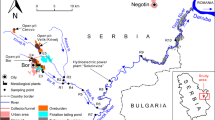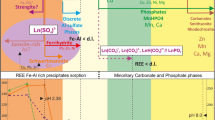Abstract
The acid mine drainage (AMD) discharged from the Hejiacun uranium mine in central Hunan (China) was sampled and analyzed using ICP-MS techniques. The analyzing results show that the AMD is characterized by the major ions FeTotal, Mn, Al and Si, and is concentrated with heavy metals and metalloids including Cd, Co, Ni, Zn, U, Cu, Pb, Tl, V, Cr, Se, As and Sb. During the AMD flowing downstream, the dissolved heavy metals were removed from the AMD waters through adsorption onto and co-precipitation with metal-oxhydroxides coated on the streambed. Among these metals, Cd, Co, Ni, Zn, U, Cu, Pb and Tl are negatively correlated to pH values, and positively correlated to major ions Fe, Al, Si, Mn, Mg, Ca and K. The metals/metalloids V, Cr, Se, As and Sb are conservative in the AMD solution, and negatively-correlated to major ions Na, Ca and Mg. Due to the above different behaviors of these chemical elements, the pH-negatively related metals (PM) and the conservative metals (CM) are identified; the PM metals include Cd, Co, Ni, Zn, U, Cu, Pb and Tl, and the CM metals V, Cr, Se, As and Sb. Based on understanding the geochemistry of PM and CM metals in the AMD waters, a new equation: EXT = (Acidity + PM)/pH + CM × pH, is proposed to estimate and evaluate extent of heavy-metal pollution (EXT) of AMD. The evaluation results show that the AMD and surface waters of the mine area have high EXT values, and they could be the potential source of heavy-metal contamination of the surrounding environment. Therefore, it is suggested that both the AMD and surface waters should be treated before they are drained out of the mine district, for which the traditional dilution and neutralization methods can be applied to remove the PM metals from the AMD waters, and new techniques through reducing the pH value of the downstream AMD waters should be developed for removal of the CM metals.






Similar content being viewed by others
References
Akabzaa TM, Armah TEK, Yakubo BKB (2007) Prediction of acid mine drainage generation potential in selected mines in the Ashanti Metallogenic belt using static geochemical methods. Environ Geol 52:957–964
Anders, Grevesse (1989) Geochemistry of chondrite. GERM Reservoir Database on web site: http://www.earthref.org.datebase
Balistrieri LS, Seal II RR, Piatak NM, Paul B (2007) Assessing the concentration, speciation, and toxicity of dissolved metals during mixing of acid-mine drainage and ambient river water downstream of the Elizabeth Copper Mine, Vermont, USA. Appl Geochem 22:930–952
Bozau E, Leblance M, Seidel JL, Stark HJ (2004) Light rare earth elements enrichment in an acidic mine lake (Lusatia, Germany). Appl Geochem 19:261–271
Brake SS, Connors KA, Romberger SB (2001) A river runs through it: impact of acid mine drainage on the geochemistry of west Little Sugar Creek pre- and post-reclamation at the Green Valley coal mine, Indiana, USA. Environ Geol 40:1471–1481
Chon HT, Hwang JH (2000) Geochemical characteristics of the acid mine drainage in the water system in the vicinity of the Dogye coal mine in Korea. Environ Geochem Health 22:155–172
Chon HT, Chon CH, Kim KW, Moon HS (1996) The occurrence and dispersion of potentially toxic elements in areas covered with black shales and slates in Korea. Appl Geochem 11:69–76
Foos A (1997) Geochemical modeling of coal mine drainage, Summit County, Ohio. Environ Geol 31(3/4):205–210
Gwiazda ES, Zurek R (2006) Distribution of trace elements in meromictic pit lake. Water Air Soil Pollut 174:181–196
Huang WK (1989) Mineralogy of the black shales of the Lower Cambrian in western Hunan (in Chinese with an English abstract). Hunan Geol 8(1):54–59
Johannesson KH, Zhou X (1999) Original of middle rare earth elements enrichments in acid waters of a Canada High Arctic lake. Geochim Cosochim Acta 63:153–165
Jung HB, Yun SK, Mayer B, Kim SO, Park SS, Lee PK (2005) Transport and sediment-water partitioning of trace metals in acid mine drainage: an example from the abandoned Kwangyand Au-Ag mine area, South Korea. Environ Geol 48:437–449
Kelley KD, Taylor CD (1997) Environmental geochemistry of shale-hosted Ag-Pb-Zn massive sulfide deposits in northwest Alaska: natural background concentrations of metals in water from mineralized areas. Appl Geochem 12:397–409
Li RJ (2001) Environmental remediation for a closed uranium mine in central Hunan (in Chinese with English abstract). Uranium Min Metall 20(2):103–107
Liu Y, Liu HC, Li XH (1996) Simultaneous and precise determination of 40 trace elements in rock samples using ICPMS (in Chinese with English abstract). Geochimica 25(6):552–558
Mckay JL, Pedersen TF, Mucci A (2007) Sedimentary redox conditions in continental margin sediments (N. E. Pacific)—influence on the accumulation of the redox-sensitive trace metals. Chem Geol 238:180–196
Neves O, Matias MJ (2007) Assessment of groundwater quality and contamination problems ascribed to an abandoned uranium mine (Cunha Baixa region, Central Portugal). Environ Geol 53(8):1779–1810 online: http://www.springerLink.com
Owor M, Hartwig T, Muwanga A, Zachmann D, Pohl W (2006) Impact of tailings from the Kilembe copper mining district on Lake George, Uganda. Environ Geol 51:1015–1075
Pandey PK, Sharma R, Roy M, Pandey M (2007) Toxic mine drainage from Asia’s biggest copper mine at malanjlhand, India. Environ Geochem and Health (in press)
Peng B, Song ZL, Tu XL, Lv HZ, Wu FC (2004) Release of heavy metals during weathering of the Lower Cambrian black shales in western Hunan, China. Environ Geol 45(8):1137–1147
Peng B, Piestrzynski A, Pieczonka J, Xie SR, Xiao ML, Wang YZ, Tang XY, Yu CX, Song Z (2007) Mineralogical and geochemical constrains on environmental impacts from waste rock at Taojiang Mn-ore deposit, central Hunan, China. Environ Geol 52:1277–1296
Preda M, Cox ME (2001) Trace metals in acid sediments and waters, Pimpama catchment, southeast Queensland, Australia. Environ Geol 40(6):755–768
Qian Y, Zheng MH, Gao L, Zhang B, Liu W, Jiao W, Zhao X, Xiao K (2005) Heavy metal contamination and its environmental risk assessment in surface sediments from Lake Dongting, People’s Republic of China. Bull Enviorn Contam Toxicol 75:204–210
Quinby-Hunt, Turekian (1983) GERM Reservoir Database on web site: http://www.earthref.org
Romero A, Gonzalez I, Galan E (2006) Estimation of potential pollution of waste mining dumps at Pena del Hirro (Pyrite Belt, SW Spain) as a base for future mitigation actions. Appl Geochem 21:1093–1108
Rose S, Ghazi AM (1998) Experimental study of the stability of metals associated with iron oxyhydroxides precipitated in acid mine drainage. Environ Geol 36(3/4):364–370
Singh TB, Mondal GC, Kumar S (2007) Major ion chemistry. Weathering processes and water quality assessment in upper catchment of Damodar River basin, India. Environ Geol 54(4):745–758 online: http://www.springerLink.com)
Tong YM (1990) Environmental pollutions from ore exploiting activities in Hunan province (in Chinese with English abstract), China. Hunan Geol 9(10):11–14
Tribovillard N, Alheo TA, Lyons T, Riboulleau A (2006) Trace elements as paleoredox and paleoproductivity proxies: an update. Chem Geol 232:12–32
Verplanck PL, Nordstrom DK, Taylor HE, Kimball BA (2004) Rare earth element partitioning between hydrous ferric oxides and acid mine water during iron oxidation. Appl Geochem 19:1339–1354
Woo NC, Choi MJ, Lee KS (2002) Assessment of groundwater quality and contamination from uranium-bearing black shale in Goesan-Boeun areas, Korea. Environ Geochem Health 24:261–273
Worrall F, Pearson DG (2001) Water–rock interaction in an acidic mine discharge as indicated by rare earth element patterns. Geochim Cosmochim Acta 65(18):3027–3043
Zheng TZ (2002) Discussion on metallogenic characteristics, formation mechanism and prospecting vistas of carbonaceous-siliceous-argillitic rock type uranium deposits. Uranium Geol 18(1):46–51
Acknowledgments
This study was subsidized by the National Scientific Foundation Committee of China (grant number 40572172). The authors wish to thank an anonymous reviewer who helped much to improve the quality of manuscript.
Author information
Authors and Affiliations
Corresponding author
Rights and permissions
About this article
Cite this article
Peng, B., Tang, X., Yu, C. et al. Heavy metal geochemistry of the acid mine drainage discharged from the Hejiacun uranium mine in central Hunan, China. Environ Geol 57, 421–434 (2009). https://doi.org/10.1007/s00254-008-1313-1
Received:
Accepted:
Published:
Issue Date:
DOI: https://doi.org/10.1007/s00254-008-1313-1




